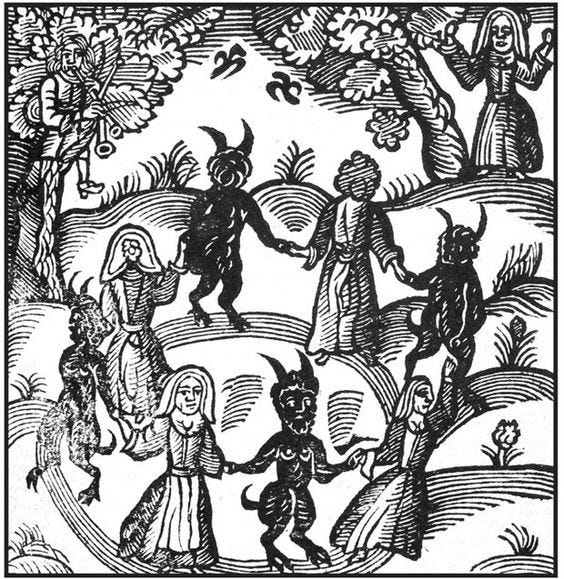In a class I’m taking called Dance and Decolonization with Dr. Tria Blu Wakpa we discussed how dance is an epistemology. (Epistemology is a fancy way of saying “a way of knowing something”, or a way of learning that something is true, rather than just a belief).
(Side note, our Witch Guide for Aquarius Season is all about the epistemologies of enchantment, to download yours scroll down).
Anyway… dance – all performance, really – is an epistemology. There are things we can learn through dancing that we can’t learn any other way.
The Necroculture (capitalist colonial culture) privileges knowledge that comes from scientific experiments; being told something is true by an authority; language, words, texts; reasoning and logic.
The idea that you could learn something through dancing is kind of a joke to the Necroculture. “You can learn dance steps, sure,” the Necroculture might tell you, “but you can’t learn anything important or useful about life.” [Insert the sound of scissors cutting NEA funding here.]
Not coincidentally, historically, many Native American people privileged (and still do privilege) dancing as not only a way of understanding their world, but as central to their culture. Dance is a means of being intimate with what they hold dear.
You won’t be surprised to learn then that the Necrostate (US and Canada) banned many indigenous forms of dance in North America until 1978.
Actually, you probably already knew how important dance was to Native American culture because if you think of the way Indian people are depicted in racist pop culture you might think of a cartoonish brown person with braids “hopping around in a war bonnet” to pow wow drums.[1] Colonial culture is always trying to find a way to belittle indigenous practices because they are threatening to its world view.
Dance is threatening to the world view of colonialism precisely BECAUSE you can learn things through dance that you can’t learn elsewhere.
When people dance they come together, they share their histories, their stories, their culture, they orient towards rhythm, non-linear forms of time, they pay attention to what their bodies are experiencing, and the messages they are receiving from the more-than-human world.

Indigenous religions tend to be based in embodiment, in communal ritual practice. Whereas Western Christianity focuses on personal faith and belief. To be a Christian, you must be a believer, to be a person of faith for many First Nations people (and many pagans, I might add), you must dance.
Note also that when the Puritans began settling in Turtle Island, Increase Mather (a Puritan minister who wrote legal documents for, and even presided over, some of the Salem Witch Trials) warned early colonists against the dances of the First Nations people. These dances conjured the devil to appear, he said. Or, as Jacqueline Shea Murphy observes…
“Indian dancing [was] rumored to call up something other than itself — which Mather [understood] as conjuring the devil.” [1]
I’m talking about all of this here for two reasons…
… first of all, I think it’s important that those of us who live on Turtle Island learn about and respect the history and practices of First Nations people.
… And also, performance, ritual, and dance as epistemology all very much apply to witchcraft (the main subject of Mystery Cult).
In fact, you might recall that many of the folk accused of witchcraft in medieval Europe were ALSO accused of dancing with the devil in the woods.
Dance, the devil and heathen ritual seem to be profoundly entangled in the Necrostate’s worldview.
Doesn’t that make you want to do it even more?
People often think of witchcraft as a means of getting something they want. And that IS one important aspect of it. But…
…practicing witchcraft is also a means to know and to learn about, to understand, our world.
So next time you are practicing a ritual (for instance, at the upcoming Full Moon Ritual) I invite you to pay attention to what you are learning through this ritual that you couldn’t learn any other way.
I invite you to think about not simply what magic gets you, but also, what kind of reality you conjure while you’re doing it.
Our Full Moon in Leo ritual begins at 6pm on this Thursday the 25th. If you’d like to attend, please become a subscriber. We’d love to see you there!
With love,
Amanda
[1] Today’s essay is very much informed by the book, “The People Have Never Stopped Dancing: Native American Modern Dance Histories,” by Jacqueline Shea Murphy.
Get Your Aquarius Season Witch Guide Here:
This month, during Aquarius season, I invite you to consider expanding your reality. In each of the exercises included in the guide, you will have the opportunity to cultivate different ways of knowing. Maybe you’ll find that you have senses you didn’t know you had. You can do one of the five options offered this month, or do them all, either way, you’ll be staying connected to your craft, AND you’ll be having fun.
Your Guide Includes:
Journal prompts for Aquarius Season
An Aquarius Season tarot spread to help you re-examine your boundaries (Aquarius is ruled by Saturn, the boundary keeper, after all)
A community ritual you can do with your friends
A ritual you can do to hear the voice of the natural world
A creative prompt to help you create your reality anew
Three Book of Shadows prompts to help you develop your craft
And a list of correspondences for Aquarius Season you can use to build your altar or create your rituals!






